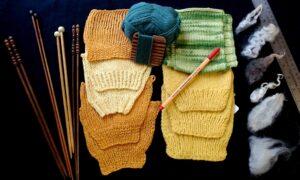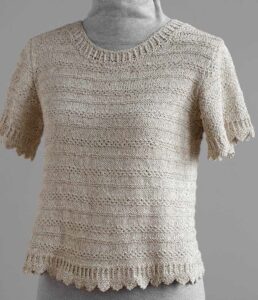(506) Fiber to Fabric: How the Underlying Fiber Informs the Knitted Fabric~ CLOSED
We are sorry, but this workshop has been closed. We are working to offer it as an online class through MAFA Virtual in early-2026.

From dependable sheep’s wool to tricky rayon, every yarn is individual. Each type of fiber, from a specific breed of sheep or other fiber-bearing animal, from plants like bamboo, hemp and flax, manmade or remanufactured, brings its own distinct benefits and challenges to a knitting project.
Learn to evaluate the potential of your particular yarn and approaches that ensure success in your hand knit garments. We will cover the roles of garment architecture, borders, and pattern stitches in preventing stretching and biasing to stabilize garments. Students will take away an understanding of fiber characteristics, yarn behavior in knitted fabrics, and an arsenal of techniques for best results.

from Storey Publishing
Instructor:
Experience Level:
Intermediate
Maximum Class Size:
18
Equipment required
No equipment, check supplies
Student Supplies:
One ball of each of the following yarns. Sport, DK or worsted weight preferred:
- 100% fine wool (for example, Merino)
- 100% longwool or coarser wool (for example, Icelandic, or Wensleydale)
- 100% other animal fiber (for example, angora, alpaca, or cashmere)
- 100% cotton
- 100% linen or hemp (be sure to get natural which is stiff, not rayon)
- 100% silk or rayon-type (look for a soft slippery yarn, rather than one that’s been processed and spun to feel like cotton. Fine yarns intended for weaving can be used doubled or tripled for knitting.)
- A small amount of stretchy fingering weight wool yarn (for example sock yarn)
Tools:
- Needles in the sizes used to knit homework, plus needles 2 and 4 sizes smaller and 2 sizes larger
- Basic knitting supplies (scissors, markers, cable needle, etc.)
- Ruler (12”-18″long)
- Calculator
- Wraps per inch (wpi) tool. You can also use your ruler, a narrow piece of cardboard, a short dowel, or a pencil marked with a 1″or 2″length using permanent marker.
- Optional: Tags for labeling swatches
- If you have one, a notably successful or a notably unsuccessful garment knit in yarn from a single fiber (i.e. 100% wool, cotton, silk, angora, linen, rayon, etc.)
Homework:
Knit 6 swatches, one from each of the yarns specified in the supplies list. Use whatever needle size you normally would for each yarn, to create a stockinette stitch fabric you like the feel and look of. Swatches should be 30 stitches by 42 rows. Begin each swatch with 8 rows of K2 P2 ribbing, then continue with 26 rows of stockinette, and finish with 8 rows of K1 P1 ribbing. Use a single needle for the whole swatch (i.e., don’t change needles size for the ribbing). Bind off. Do not block. Keep a record of needle size used for each swatch. Bring swatches and remaining yarn to class.
